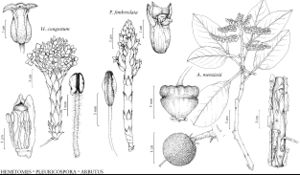Arbutus
Sp. Pl. 1: 395. 1753.
Gen. Pl. ed. 5, 187. 1754 ,.
Shrubs or trees, sometimes with swollen burl-like base (capable of resprouting after fire); bark red or reddish-brown, exfoliating in flakes on young axes, retained on oldest portions of trunk and abaxial side of major limbs where forming an irregular checked pattern, or bark at first flaking on young branchlets then retained, eventually uniformly checkered over all main axes (A. arizonica). Stems erect, branching; young branchlets glandular-hairy, thinly tomentose, or both, or glabrous; new growth of rapidly elongating sprouts usually with glandular-hairs; (buds ovate, apex acute, glossy red, sometimes glabrate, usually only terminal buds well developed and conspicuous; bud-scales accrescent, 8–16, imbricate). Leaves bifacial or isofacial; blade ovate (widest slightly proximal to middle) or elliptic, coriaceous, margins entire or finely to coarsely toothed on sprouts and sterile shoots, plane, surfaces ± glabrous. Inflorescences clusters of racemes, 10–40-flowered. Flowers bisexual; sepals persistent, 5, connate basally, ovate to deltate; petals 5, connate nearly their entire lengths, creamy white [yellowish], corolla urceolate, (soon developing post-anthesis circumferential dimple near mid length, base inflated); stamens 10, included, (distinct); filaments slender distally, abruptly expanded proximally into swollen base, (villous proximally); anthers with 2 dorsal awns adaxially, dehiscent by subterminal, elliptic pores; ovary 5-locular; stigma capitate. Berries orange-red, red, or blackish red, ± globose or slightly turbinate, juicy, roughened-tuberculate, glabrous or thinly hairy; pyrenes 1–5, not connate into stone. Seeds 1–5, distinct, (irregularly angled). x = 13.
Distribution
sw, w North America, Mexico, Central America, s, w Europe, n Africa, n Atlantic Islands (Canary Islands)
Discussion
Unedo Hoffmansegg & Link
Species 10 (3 in the flora).
Five species of Arbutus occur in the Neotropics, and all extend north of the Tropic of Cancer. In the Tropics, the plants are found primarily in montane areas associating with Pinus and Quercus species. Populations north of Mexico inhabit riverine woodlands (A. arizonica) or progressively drier environments, associating with pinyon-juniper vegetation (A. xalapensis) in Texas and New Mexico, and dry wooded slopes and canyons (A. menziesii) in California, Oregon, and southwestern Washington, increasingly moist but well-drained habitats in northwestern Washington, islands of Puget Sound and San Juan Archipelago, and southwestern British Columbia.
Species of Arbutus are easily confused with some members of the genus Comarostaphylis because of the exfoliating bark and berrylike fruit common to both. The fruit alone distinguishes them: Arbutus species produce a true berry with multiple locules and seeds, whereas Comarostaphylis species produce a drupe with one central stone enclosing a single seed. Taxonomically, the Arbutus species of the Old World and New World are included in a single genus. A. P. de Candolle (1839) perceived a morphological distinction between the two geographic groups. He maintained a single genus and established two subgenera that he named Gerontogeae (sect. Arbutus) for the Old World taxa and Americanae for those of the New World. L. C. Hileman et al. (2001) presented corroborative molecular data suggesting that the two geographic groups represent separate lineages.
Arbutus unedo is cultivated as an ornamental tree in California, where it flowers and fruits. It is reported to succeed in the USDA hardiness zones 8–10, extending along the Pacific Coast from southwestern Oregon into the region north of Los Angeles, California. It grows also in all of coastal Washington and southwestern British Columbia.
Selected References
None.
Lower Taxa
Key
| 1 | Leaf blades usually tapered-acute at base, rarely rounded; bark light gray to reddish gray, checkered with squarish to rectangular segments or plates, 1-4 × 1-2.5 cm, retained on bole and major limbs; twigs 3+ years old with brick-red outer bark exfoliating in flakes or, sometimes, in slender strips. | Arbutus arizonica |
| 1 | Leaf blades usually rounded or subcordate at base, sometimes tapered; bark on young twigs exfoliating in irregular strips, exfoliating on larger limbs and bole in flakes and sheets, older bark retained only at base of tree or on abaxial sides of larger limbs | > 2 |
| 2 | Plants 4-10(-20) m; leaf blades 6.5-13 × 3.5-6(-8) cm, glaucous-green abaxially; western coast of North America. | Arbutus menziesii |
| 2 | Plants 2-4(-8) m; leaf blades (2.5-)4-6(-7.5) × (1.2-)1.8-3(-4) cm, green or slightly lighter green abaxially; New Mexico, Texas | Arbutus xalapensis |
"entire" is not a number.
